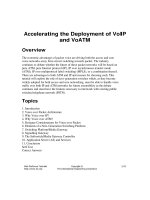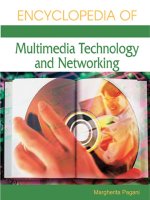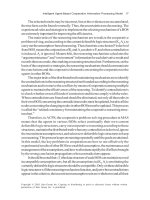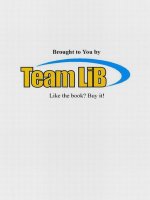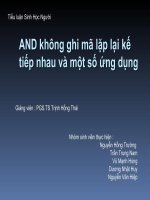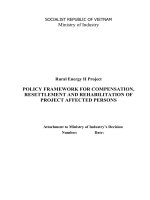Tài liệu Beyond Productivity: Information, Technology, Innovation, and Creativity pdf
Bạn đang xem bản rút gọn của tài liệu. Xem và tải ngay bản đầy đủ của tài liệu tại đây (2.82 MB, 268 trang )
Committee on Information Technology and Creativity
Computer Science and Telecommunications Board
Division on Engineering and Physical Sciences
William J. Mitchell, Alan S. Inouye, and Marjory S. Blumenthal,
Editors
THE NATIONAL ACADEMIES PRESS
Washington, D.C.
www.nap.edu
THE NATIONAL ACADEMIES PRESS
500 Fifth Street, N.W., Washington, DC 20001
NOTICE: The project that is the subject of this report was approved by the
Governing Board of the National Research Council, whose members are drawn
from the councils of the National Academy of Sciences, the National Academy
of Engineering, and the Institute of Medicine. The members of the committee
responsible for the report were chosen for their special competences and with
regard for appropriate balance.
Support for this project was provided by the Rockefeller Foundation. Any
opinions, findings, conclusions, or recommendations expressed in this mate-
rial are those of the authors and do not necessarily reflect the views of the
sponsor.
International Standard Book Number 0-309-08868-2
Library of Congress Control Number 2003103683
Cover design by Jennifer M. Bishop
Copies of this report are available from the National Academies Press, 500
Fifth Street, N.W., Lockbox 285, Washington, DC 20055, (800) 624-6242 or (202)
334-3313 in the Washington metropolitan area. Internet, .
Copyright 2003 by the National Academy of Sciences. All rights reserved.
Printed in the United States of America
The National Academy of Sciences is a private, nonprofit, self-perpetuating
society of distinguished scholars engaged in scientific and engineering re-
search, dedicated to the furtherance of science and technology and to their use
for the general welfare. Upon the authority of the charter granted to it by the
Congress in 1863, the Academy has a mandate that requires it to advise the
federal government on scientific and technical matters. Dr. Bruce M. Alberts
is president of the National Academy of Sciences.
The National Academy of Engineering was established in 1964, under the
charter of the National Academy of Sciences, as a parallel organization of
outstanding engineers. It is autonomous in its administration and in the
selection of its members, sharing with the National Academy of Sciences the
responsibility for advising the federal government. The National Academy of
Engineering also sponsors engineering programs aimed at meeting national
needs, encourages education and research, and recognizes the superior achieve-
ments of engineers. Dr. Wm. A. Wulf is president of the National Academy of
Engineering.
The Institute of Medicine was established in 1970 by the National Academy
of Sciences to secure the services of eminent members of appropriate profes-
sions in the examination of policy matters pertaining to the health of the
public. The Institute acts under the responsibility given to the National
Academy of Sciences by its congressional charter to be an adviser to the
federal government and, upon its own initiative, to identify issues of medical
care, research, and education. Dr. Harvey V. Fineberg is president of the
Institute of Medicine.
The National Research Council was organized by the National Academy of
Sciences in 1916 to associate the broad community of science and technology
with the Academy’s purposes of furthering knowledge and advising the
federal government. Functioning in accordance with general policies deter-
mined by the Academy, the Council has become the principal operating
agency of both the National Academy of Sciences and the National Academy
of Engineering in providing services to the government, the public, and the
scientific and engineering communities. The Council is administered jointly
by both Academies and the Institute of Medicine. Dr. Bruce M. Alberts and
Dr. Wm. A. Wulf are chair and vice chair, respectively, of the National Re-
search Council.
www.national-academies.org
v
COMMITTEE ON INFORMATION
TECHNOLOGY AND CREATIVITY
WILLIAM J. MITCHELL, Massachusetts Institute of Technology, Chair
STEVEN ABRAMS, IBM T.J. Watson Research Center
MICHAEL CENTURY, Rensselaer Polytechnic Institute
JAMES P. CRUTCHFIELD, Santa Fe Institute
CHRISTOPHER CSIKSZENTMIHALYI, MIT Media Laboratory
ROGER DANNENBERG, Carnegie Mellon University
TONI DOVE, Independent Artist, New York City
N. KATHERINE HAYLES, University of California at Los Angeles
J.C. HERZ, Joystick Nation Inc.
NATALIE JEREMIJENKO, Yale University
JOHN MAEDA, MIT Media Laboratory
DAVID SALESIN, University of Washington; Microsoft Research
LILLIAN F. SCHWARTZ, Computer Artist-Inventor, Watchung, New Jersey
PHOEBE SENGERS, Cornell University
BARBARA STAFFORD, University of Chicago
Staff
ALAN S. INOUYE, Study Director and Senior Program Officer
MARJORY S. BLUMENTHAL, Director, Computer Science and
Telecommunications Board
DAVID PADGHAM, Research Associate
MARGARET MARSH HUYNH, Senior Project Assistant
LAURA OST, Consultant
DAVID WALCZYK, Consultant
SUSAN MAURIZI, Senior Editor
JENNIFER M. BISHOP, Senior Project Assistant
vi
COMPUTER SCIENCE AND
TELECOMMUNICATIONS BOARD
DAVID D. CLARK, Massachusetts Institute of Technology, Chair
ERIC BENHAMOU, 3Com Corporation
DAVID BORTH, Motorola Labs
JOHN M. CIOFFI, Stanford University
ELAINE COHEN, University of Utah
W. BRUCE CROFT, University of Massachusetts at Amherst
THOMAS E. DARCIE, AT&T Labs Research
JOSEPH FARRELL, University of California at Berkeley
JOAN FEIGENBAUM, Yale University
WENDY KELLOGG, IBM T.J. Watson Research Center
BUTLER W. LAMPSON, Microsoft Corporation
DAVID LIDDLE, U.S. Venture Partners
TOM M. MITCHELL, Carnegie Mellon University
HECTOR GARCIA MOLINA, Stanford University
DAVID A. PATTERSON, University of California at Berkeley
HENRY (HANK) PERRITT, Chicago-Kent College of Law
DANIEL PIKE, Classic Communications Inc.
ERIC SCHMIDT, Google Inc.
FRED SCHNEIDER, Cornell University
BURTON SMITH, Cray Inc.
LEE SPROULL, New York University
WILLIAM STEAD, Vanderbilt University
JEANNETTE M. WING, Carnegie Mellon University
MARJORY S. BLUMENTHAL, Director
HERBERT S. LIN, Senior Scientist
ALAN S. INOUYE, Senior Program Officer
JON EISENBERG, Senior Program Officer
LYNETTE I. MILLETT, Program Officer
CYNTHIA A. PATTERSON, Program Officer
STEVEN WOO, Dissemination Officer
JANET BRISCOE, Administrative Officer
RENEE HAWKINS, Financial Associate
DAVID PADGHAM, Research Associate
KRISTEN BATCH, Research Associate
PHIL HILLIARD, Research Associate
MARGARET MARSH HUYNH, Senior Project Assistant
DAVID DRAKE, Senior Project Assistant
JANICE SABUDA, Senior Project Assistant
JENNIFER M. BISHOP, Senior Project Assistant
BRANDYE WILLIAMS, Staff Assistant
For more information on CSTB, see its Web site at <>,
write to CSTB, National Research Council, 500 Fifth Street, N.W., Washing-
ton, DC 20001, call at (202) 334-2605, or e-mail the CSTB at
vii
C
Preface
omputer science has drawn from and contributed to many
disciplines and practices since it emerged as a field in the
middle of the 20th century. Those interactions, in turn,
have contributed to the evolution of information technol-
ogy: New forms of computing and communications, and new appli-
cations, continue to develop from the creative interaction of computer
science and other fields. Focused initially on interactions between
computer science and other forms of science and engineering, the
Computer Science and Telecommunications Board (CSTB) began in
the mid-1990s to examine opportunities at the intersection of comput-
ing and the humanities and the arts. In 1997, it organized a workshop
that illuminated the potential, as well as the practical challenges, of
mining those opportunities
1
and that led, eventually, to the project
described in this report. Ensuing discussions between CSTB staff and
people interested in the intersection of computing and the humanities
or the arts, notably Joan Shigekawa of the Rockefeller Foundation, a
participant in the 1997 workshop, culminated in a grant from the
Rockefeller Foundation to study information technology and creativ-
ity (see Box P.1 for the statement of task).
This report should be read with two conditions in mind: First, it
is, by design, a record of the project, filled with descriptions, observa-
tions, conclusions, and recommendations intended to motivate and
sustain interest and activity in the rich intersection of information
technology (IT) and the arts and design. Second, in this book form it
cannot possibly convey the exciting possibilities at that intersection.
Instead, it presents examples and pointers to sites on the World Wide
Web and in the physical world where that intersection can be ob-
served and experienced. We urge the reader to treat this report as a
1
See Computing and the Humanities: Summary of a Roundtable Meeting, published in
1998 by the American Council of Learned Societies, one of three collaborators with
CSTB in organizing the workshop.
PREFACE
viii
•••••••••••••••••••••••••••••••••••••••••
primer and guidebook and to seek out instances of IT and creative
practices—ITCP—directly.
COMMITTEE COMPOSITION AND
PROCESS
The study committee convened by CSTB featured an unusually
eclectic group of individuals (see Appendix A for biographies of com-
mittee members). Characterizing most (or all) of them as experts on
particular subjects would only begin to suggest the talents of this
group. Collectively, the committee had expertise and experience in
the intersections of information technology and music, the visual arts,
film, and literature and in art history, architecture, cultural studies,
and many of the technologies pertinent to ITCP. The committee did its
work through its own deliberations and by soliciting input from a
number of other experts (see Appendix B for a list of those who briefed
the committee). It met first in August 2000 and five times subse-
quently in plenary session. Additional information was derived from
reviewing the published literature, monitoring selected listservs and
Web sites, and obtaining informal input at various conferences and
other convenings. During the editorial phase of the study, facts were
checked for accuracy with either authoritative published sources or
subject experts.
The diversity of this committee made it a microcosm of some of
the communities it hopes to influence with this report. That diversity
posed challenges in the conduct of this project that will be echoed in
attempts to learn from it: Conversations among people with different
training and professional experience can be confounded by jargon and
BOX P.1
Statement of Task
A series of discussions among a cross section of the arts community and
experts in computing and communications will be organized. These discus-
sions will crystallize new ways of conceptualizing joint opportunities and new
approaches to the arts (and/or IT [information technology]). They will
explore what would make the most conducive environment for IT-arts
exchange on an ongoing basis, considering physical and virtual options. They
will address possible mechanisms to sustain the discussion, such as funding
and institutional support. Finally, they will culminate in both a coherent
description of potential futures and an agenda for action, action that bridges
the different communities as well as action most appropriate for one or
another.
PREFACE
ix
prejudices as well as by differing knowledge bases—even when those
people share interests. The completion of this report attests to the
potential for technologists and artists to find common ground, not
only in undertaking creative work, but also in contemplating options
for making such work easier to undertake and more widespread. But
finding this common ground sometimes proved to be a formidable
challenge.
The productive interaction among committee members was cap-
tured in some of their career developments during the course of this
project. Chris Csikszentmihalyi, for example, left Rensselaer Poly-
technic Institute to join John Maeda at MIT’s Media Lab. Michael
Century left McGill University for Rensselaer Polytechnic Institute.
Natalie Jeremijenko was hosted by Jim Crutchfield for a month’s
professional visit at the Santa Fe Institute. And John Maeda was
inspired by the project to build “a new online Bauhaus.” These and
other developments attest to the dynamism and creative energy of the
people who have been exploring the intersection of IT and creativity.
Although the report refers to several companies, products, and
services by name, such reference does not constitute an endorsement
by the committee or the National Academies. The committee did not
evaluate any product or service in sufficient detail to allow such an
endorsement.
ACKNOWLEDGMENTS
The committee is particularly grateful to Joan Shigekawa of the
Rockefeller Foundation for initiating this study. She approached CSTB
with a conviction that the time was right for a conversation among
people of different backgrounds about how to enhance and sustain the
intersection of information technology and creative practices. We
appreciate her guidance and support through the study process, in-
cluding her participation in two committee meetings, occasional relay
of useful information, and continuing demonstration of interest in the
process and the eventual results.
In addition, we would like to thank those individuals who pro-
vided valuable inputs into the committee’s deliberations. Those who
briefed the committee at one of our plenary meetings are listed in
Appendix B. Others who provided us with important inputs include
Bill Alschuler (California Institute of the Arts), Howard Besser (New
York University), Shari Garmise (Consultant, Washington, D.C.),
Samuel Hope (National Office for Arts Accreditation), Sharon Kangas
(Center for Arts and Culture), Anna Karlin (University of Washing-
ton), Ruth Kovacs (The Foundation Center), Joan Lippincott (Coalition
for Networked Information), and Laurens R. Schwartz (Consultant,
New York City). We would also like to acknowledge those organiza-
tions that hosted committee meetings: the American Institute of
•••••••••••••••••••••••••••••••••••••••••
PREFACE
x
Graphic Arts, New York University, Stanford University, Pixar Ani-
mation Studios, and the Massachusetts Institute of Technology.
The committee appreciates the thoughtful comments received from
the reviewers of this report and the efforts of the National Research
Council’s report review coordinator. The review draft stimulated a
comparatively large volume of comments, many of which provided
additional reference material, relevant anecdotes, and observations to
bolster or counter the committee’s earlier thinking. The comments
were instrumental in helping the committee to sharpen and improve
this report. In particular, Simon Penny of the University of California
at Irvine provided an unusually extensive and thoughtful set of com-
ments that served to improve the quality of this final report.
Finally, the committee would like to acknowledge the staff of the
NRC for their work. Alan Inouye served as the study director with
overall staff responsibility for the conduct of the study and the devel-
opment of this final report; his effort to bring the report to completion
was exceptional and demanded far more of his time than anticipated.
Marjory Blumenthal, director of the CSTB, provided essential guid-
ance and input throughout the study process, drafted and edited a
number of sections of the final report, and was both helpful and
patient in bringing the committee process to a successful conclusion.
Margaret Marsh Huynh had primary responsibility for the adminis-
trative aspects of the project such as organizing meeting logistics; her
efforts made a particularly complicated and demanding process run
smoothly. Consultants Laura Ost and David Walczyk generated ini-
tial drafts of several sections of the report; Ms. Ost also edited several
chapters. Susan Maurizi edited the manuscript for publication. David
Padgham and Jennifer Bishop provided research assistance; Ms. Bishop
also created several of the original figures that appear in this report
(including the cover design). The committee also thanks Janet Briscoe,
Janice Sabuda, and Brandye Williams of the CSTB, and Claudette K.
Baylor-Fleming and Carmela J. Chamberlain of the Space Studies Board
for their support of the committee’s work.
William J. Mitchell, Chair
Committee on Information Technology and Creativity
xi
T
Acknowledgment of
Reviewers
his report has been reviewed in draft form by individuals
chosen for their diverse perspectives and technical exper-
tise, in accordance with procedures approved by the Na-
tional Research Council’s Report Review Committee. The
purpose of this independent review is to provide candid and critical
comments that will assist the institution in making its published re-
port as sound as possible and to ensure that the report meets institu-
tional standards for objectivity, evidence, and responsiveness to the
study charge. The review comments and draft manuscript remain
confidential to protect the integrity of the deliberative process. We
wish to thank the following individuals for their review of this report:
Anna Bentkowska, Conway Library, Courtauld Institute of Art,
Howard Besser, New York University,
Sandra Braman, University of Alabama,
Donna Cox, University of Illinois at Urbana-Champaign,
Robert Denison, First Security Company,
Steve Dietz, Walker Art Center,
Kristian Halvorsen, Hewlett Packard Laboratories,
Paul Kaiser, Independent Artist, New York City,
Alan Kay, Hewlett Packard Company,
Clifford Lynch, Coalition for Networked Information,
Simon Penny, University of California at Irvine,
Bill Seaman, Rhode Island School of Design, and
Mark Tribe, Rhizome.org.
Although the reviewers listed above have provided many con-
structive comments and suggestions, they were not asked to endorse
the conclusions or recommendations, nor did they see the final draft of
the report before its release. The review of this report was overseen by
Edward Lazowska, University of Washington. Appointed by the
ACKNOWLEDGMENTS
xii
National Research Council, he was responsible for making certain that
an independent examination of this report was carried out in accor-
dance with institutional procedures and that all review comments
were carefully considered. Responsibility for the final content of this
report rests entirely with the authoring committee and the institution.
xiii
Contents
SUMMARY AND RECOMMENDATIONS 1
INFORMATION TECHNOLOGY, PRODUCTIVITY,
AND CREATIVITY 15
Inventive and Creative Practices, 16
Domains and Benefits of Creativity, 18
The Creative Industries, 20
Interactions Among Domains of Creative Activity, 22
The Roles of Information Technology, 24
The Race for Creativity in a Networked World, 27
Roadmap for This Report, 28
CREATIVE PRACTICES 30
What Makes People Creative, 30
How Creative People Work, 34
Individuals with Diverse Expertise and Skills, 36
Successful Collaborations, 40
Architecture, 44
Movie Production, 45
Computer Games, 48
Cultural Challenges in Cross-disciplinary Collaborations, 51
Overcoming Preconceived Notions About Computer Scientists
and Artists and Designers, 52
Minimizing Communications Clashes, 55
Resources That Support Creative Practices, 57
Skills Training, 57
Work Spaces, 58
ADVANCING CREATIVE PRACTICES THROUGH
INFORMATION TECHNOLOGY 61
Strange Bedfellows?, 61
Tools Needed to Support Creative Work: Hardware and Software, 65
2
1
3
CONTENTS
xiv
Hardware and Software Tools: A Mixed Blessing, 68
Support for Flexibility, Experimentation, and Play, 74
The Internet and the Web, 75
Economic Realities, 81
Standards, 84
Selected Areas for the Development of Hardware
and Software That Would Promote Creative Work, 86
Distributed Control, 87
Sensors and Actuators, 88
Video and Audio, 89
Generative Processes, 92
Reliable, Low-latency Communication over the Internet, 93
Tool Design and Human-Computer Interaction, 94
Programming Languages, 95
THE INFLUENCE OF ART AND DESIGN ON COMPUTER
SCIENCE RESEARCH AND DEVELOPMENT 96
Beyond Tools, 96
The Information Arts, 96
Modeling Disciplines: From Multidisciplinary to Transdisciplinary, 99
Implications for Computer Science, 102
Promising Areas, 104
Mixed Reality, 105
Computer Games, 107
Narrative Intelligence, 108
Non-utilitarian Evaluation, 111
Experimental Consumer Product Design, 112
Mobile and Ubiquitous Computing, 113
Conclusion, 115
VENUES FOR INFORMATION TECHNOLOGY AND
CREATIVE PRACTICES 118
Studio-Laboratories, 119
Historical Perspective, 119
Three Classes of Modern Studio-Laboratories, 120
Multifaceted New-Media Art and Design Organizations, 125
Standalone Centers, 125
Hybrid Networks, 128
Other Venues for Practitioners, 130
Virtual-Space-based Strategies, 130
Professional Conferences, 133
Public Display Venues, 136
Corporate Experiences with Information Technology and
Creative Practices, 143
SCHOOLS, COLLEGES, AND UNIVERSITIES 151
Organizational Models for Supporting Work, 152
Specialized Centers, 152
Workshops, 155
Service Units, 157
4
5
6
CONTENTS
xv
Fostering ITCP Work Within Mainstream Departments and
Disciplines, 158
Computer Science, 158
Examples of ITCP Work, 159
Challenges in Computer Science Departments, 162
Art Practice and Design, 165
Schools of Art and Design, 167
Cross-cutting Issues, 170
Hiring Faculty, 170
Encouraging Multiskilled Individuals and Collaborations, 171
Designing Curricula, 173
INSTITUTIONAL ISSUES AND PUBLIC POLICY 176
Digital Copyright, 177
Digital Archiving and Preservation, 181
Validation and Recognition Structures, 184
Publication, 188
Curatorial Web Sites, 189
Awards and Prizes, 190
The Geography of Information Technology and Creative Practices, 191
Information Technology Hot Spots, 192
Geographically Distributed Creativity, 194
Technology-supported Networks of Creativity, 195
SUPPORTING WORK IN INFORMATION TECHNOLOGY AND
CREATIVE PRACTICES 197
Funding in the United States, 199
Sources of Funds, 200
Federal Funding for the Arts—The National Endowments, 202
Indirect Public Funding for the Arts, 204
Funding by Private Philanthropy, 205
Prizes, 210
Federal Funding for Information Technology Research, 211
Funding for Infrastructure, 213
Risk Preferences and the Challenge of Supporting Emerging Areas, 216
Reexamining Funding Policies and Practices, 220
Funding in the International Context, 225
Public Support for the Arts, 225
Public Support for Information Technology Research, 230
Private Philanthropy, 234
APPENDIXES
Biographies of Committee Members and Staff 237
Briefers at Committee Meetings 247
The Computer Science and Telecommunications Board 251
7
8
A
B
1
C
Summary and Recommendations
reativity plays a crucial role in culture; creative activities
provide personal, social, and educational benefit; and cre-
ative inventions (“better recipes, not just more cook-
ing”) are increasingly recognized as key drivers of eco-
nomic development. But creativity takes different forms at different
times and in different places. This report argues that, at the beginning
of the 21st century, information technology (IT) is forming a powerful
alliance with creative practices in the arts and design to establish the
exciting new domain of information technology and creative prac-
tices—ITCP. There are major benefits to be gained from encouraging,
supporting, and strategically investing in this domain.
INFORMATION TECHNOLOGY AND
CREATIVE PRACTICES
Alliances of technology and creative practices have often emerged
in the past. In the 19th century, for example, optical, chemical, and
thin-film manufacturing technologies converged with the practices of
the pictorial arts to establish the new domain of photography. Then,
photographic technology became further allied with the practices of
the performing arts, giving rise to the domain of film. The cultural and
economic consequences of these developments have been profound.
The emerging alliance of information technology with the arts and
design has, this committee believes, even greater potential.
ITCP has already yielded results of astonishing variety and sig-
nificant cultural and economic value. These results have taken such
forms as innovative architectural and product designs, computer ani-
mated films, computer music, computer games, Web-based texts, and
•••••••••••••••••••••••••••••••••••••••••
BEYOND PRODUCTIVITY
2
•••••••••••••••••••••••••••••••••••••••••
interactive art installations, to name just a few. They have developed
from individual, group, and institutional activities; the processes by
which they have been produced have spanned both the commercial
and not-for-profit worlds and the formal and informal economic sec-
tors. The products of ITCP have begun to appear in many different
countries, in ways that reflect cultural, economic, and political differ-
ences.
IT has now reached a stage of maturity, cost-effectiveness, and
diffusion that enables its effective engagement with many areas of the
arts and design—not just to enhance productivity or to allow more
efficient distribution, but to open up new creative possibilities. There
is a highly competitive race for leadership in this domain. The poten-
tial payoffs from success in the near- and long-term futures are enor-
mous: billion-dollar industries, valuable exports, thriving communi-
ties that attract the best and the brightest, enriched cultural experiences
for individuals and communities, and opportunities for global cul-
tural visibility and influence.
By definition, there is no formula for creativity. But there are
effective ways to invest in establishing conditions necessary for ITCP,
in overcoming impediments, and in providing incentives. Further-
more, there are ways to recognize and reward creative contributions
and to derive social benefit from them. In appropriate combination,
these measures can add up to powerful strategies for encouraging,
supporting, and reaping the rewards of ITCP. Development along
with implementation of such strategies is the challenge addressed by
this report.
MULTILEVEL STRATEGIES FOR ITCP
ITCP can be engaged at multiple levels—by individual artists and
designers who deal with IT tools, media, and themes; in the structur-
ing and management of cross-disciplinary research and production
groups working in the ITCP domain; in directing educational and
cultural institutions with interests in ITCP; at the level of regional
development strategy aimed at fostering ITCP clusters; as an aspect of
national economic and cultural policy; and in multinational collabora-
tive efforts. All of these levels are important, and there are cross-
connections among them. There is, therefore, considerable advantage
in coordinated, multilevel strategies for encouraging, supporting, and
benefiting from ITCP.
•••••••••••••••••••••••••••••••••••••••••
SUMMARY AND RECOMMENDATIONS
3
PROVIDING NEW TOOLS AND
MEDIA FOR ARTISTS AND
DESIGNERS
Individual artists and designers have experimented with IT since
its earliest incarnations. Artistic exploration of the possibilities of com-
puter graphics, for example, now extends back more than 30 years,
and 40 years for computer music. As IT has matured and been assimi-
lated into the mass market, the IT tools and media available to artists
and designers have become both more diversified and more afford-
able. There are popular, standardized tools for performing such tasks
as creating, editing, and distributing images, audio, and text; there are
variants on standard tools customized to the needs of particular artists
or designers; and there are highly specialized, purpose-built tools
used by nobody but their creators.
To a software developer or an information services manager, it
might seem that the keys to ITCP are simply equipment and soft-
ware—developing and providing access to standard, commercial IT
tools for artists and designers. This perspective is useful as far as it
goes, and it can provide a good way to get started with ITCP, but in
the long run it is an insufficiently rich or flexible one. We make our
tools; then our tools make us.
1
Furthermore, software tools encode
numerous assumptions about the making of art and design—precisely
the sorts of presuppositions that truly creative practitioners will want
to challenge. And the more software tools emphasize ease of use or
familiar metaphors, the more they must depend on restrictive as-
sumptions in order to do so. Such tools not only must be available, but
they also must be objects of critical reflection; they must be open to
adjustment and tweaking, they must support unintended and subver-
sive uses—not just anticipated ones—and they must not be too resis-
tant to being torn apart and reconceived. If creative practice can de-
velop the powerful spaces and tools that it needs, like the electronic
easel or electronic studio, these spaces and tools could help transform
or enlarge the metaphors, spaces, and tools (office, desktop, files) that
the rest of us have to work with.
The relationship between IT professionals and artists and design-
ers will be of limited value if it is conceived simply as one of software
(or hardware) producer and consumer. It should, instead, be one of
flexible and thoughtful collaboration in which the roles of software
designer and user are not rigidly distinguished. The advances made
by IT researchers may suggest new forms of art and design practice,
1
Inspired by Marshall McLuhan, 1954, “Notes on the Media as Art Forms,” Explora-
tions 2 (April): 6-13.
BEYOND PRODUCTIVITY
4
•••••••••••••••••••••••••••••••••••••••••
while the questions raised by artists and designers may provide new
ways of thinking about IT—ITCP work challenges the boundaries of
traditional disciplines. Modular, reusable and recombinable code ele-
ments may support critical reconceptualization more readily than
closed, proprietary software products. Open source development may
provide better opportunities for cross-disciplinary collaboration,
customization, and reconceptualization than tools developed and mar-
keted as protected intellectual property—no matter how powerful and
attractive those tools may be.
PROVIDING OPPORTUNITIES TO
DEVELOP ITCP SKILLS
In general, ITCP depends on opportunities for learning across
multiple disciplines—some mix of the arts and design plus IT concepts
and tools. The growing numbers of artists and designers becoming
skilled programmers or hardware developers, like the smaller number
of computer scientists and technologists engaging seriously with the
arts and design, demonstrates that this is feasible. But it is not easy:
Colleges and universities focus mostly on established disciplines, and
the cross-disciplinary programs that do exist vary widely in their
institutional support, effectiveness, and quality.
Like other professionals, artists and designers can do more with IT
if they become deeply conversant with its capabilities and limitations.
Achieving that result requires far more than training on standard
tools, and it also demands an ability to understand tools and media
critically—in cultural and historical context. Such critical thinking
about tools is much less typical of education and training in IT, a
difference that contributes to the asymmetric participation of artists
and computer scientists in ITCP. To date, it seems that artists and
designers have made greater efforts to engage IT seriously than com-
puter scientists and technologists have made to acquire deep under-
standing of creative practices in the arts and design. It is easier to find
designers who can program than programmers who can design, or
composers comfortable with signal processing than specialists in sig-
nal processing who can compose or perform at high levels of profi-
ciency. This imbalance could change, with outreach to the computer
science community and interest in ITCP among those who provide
funding and other incentives and rewards.
Although motivated individuals can and do acquire complemen-
tary IT and arts or design skills, significant ITCP work can also be
produced by cross-disciplinary partnerships between computer scien-
tists and artists or designers. This approach has the advantage of
requiring that fewer skills be mastered by individual team members,
and it is often essential for large projects, but there are some inherent
difficulties. Progress in collaborative ITCP requires effective dialogue
SUMMARY AND RECOMMENDATIONS
5
between artists and designers and IT professionals. Differences in
professional culture, styles, and values, as well as communication
problems, can confound effective collaboration. Yet there are strong
traditions of successful cross-disciplinary collaboration in architecture
(particularly as computer-aided design/computer-aided manufactur-
ing (CAD/CAM) technology plays an increasing role), in film produc-
tion, and in the creation of video games, and there have been some
successful pairings of artists and technologists to produce visual works,
performances, and installations.
CREATING ENVIRONMENTS THAT
SUPPORT ITCP
ITCP work can be done in many different places. And the diver-
sity of venues matters, since each type of venue represents different
tradeoffs and provides different combinations of opportunities, con-
straints, and comparative advantage. So an effective ITCP develop-
ment strategy is likely to be a multivenue one.
ITCP venues may occupy physical or virtual spaces, be large or
small, range from loosely organized collectives to formal programs,
and be either free-standing or connected to established institutions.
Specialized exhibitions, performance festivals, presentation and lec-
ture series, conferences, Internet forums, and display and performance
sites have all played important roles in the growth of ITCP communi-
ties. By contrast, mainstream arts and design organizations—muse-
ums, galleries, arts and design fairs, arts and design publishers, and so
on—have played a lesser role, although they have begun to embrace
ITCP more as the products of ITCP have played a larger cultural role
and as these products have developed in quality and interest.
Much pioneering exploration of ITCP has taken place in studio-
laboratories, which build on the tradition of earlier centers of cross-
disciplinary research and education in the arts, design, and new tech-
nology of the time, such as Germany’s Bauhaus in the pre-World War
II years, the postwar New Bauhaus in Chicago, and the Center for
Advanced Visual Studies established by Gyorgy Kepes at the Massa-
chusetts Institute of Technology (MIT) in the 1960s. MIT’s Media
Laboratory has been among the largest and most visible, and it has
generated affiliates in Europe and Asia. However, the Media Lab’s
combination of substantial laboratory and human resources with an
atelier style of research and education, building on a consortium of
industry funders, is difficult to replicate outside the context of a lead-
ing research university with strong industrial connections. Some uni-
versities, such as Carnegie Mellon University, have formed special
cross-disciplinary centers that undertake ITCP, and several arts schools,
such as the California Institute of the Arts and the Art Center College
of Design in Pasadena, have transformed their curricula to incorporate
•••••••••••••••••••••••••••••••••••••••••
BEYOND PRODUCTIVITY
6
IT, yielding numerous focused ITCP activities. Some film schools have
shifted their emphasis from traditional to digital production and dis-
tribution technologies, and most architecture and design schools have
supplemented or supplanted drawing boards with CAD. Several uni-
versities have begun to develop cross-disciplinary study programs in
aspects of ITCP. But a key challenge, particularly in times of tight
finances, is to find effective ways to fund these programs—and to
frame them in ways that are pedagogically sound and appropriately
adaptive to the continuing evolution of ITCP.
In Canada and Europe, and emerging in Asia and Australia, major
efforts are under way to develop standalone, government-backed ITCP
centers. Such centers are typically conceived of as instruments of arts
and cultural policy, rather than as equivalents of national research
laboratories. This is an arena in which the United States lags. In prin-
ciple, such centers can provide considerable flexibility and freedom of
intellectual direction. On the down side, they are vulnerable to changes
in government spending priorities, they can lose the very indepen-
dence that makes them attractive if they shift to executing contracts
from industry, and they are usually less able to draw effectively on the
laboratories and human resources of large universities.
The technology required for ITCP can be expensive, and ambi-
tious ITCP productions can require major funding. Given the breadth
of ITCP, some funding is available through commercial channels. It
normally requires close engagement with popular culture and mass
audiences, with all the constraints and opportunities that this implies.
This path is illustrated by the film and entertainment industries—
these ITCP pioneers overcame difficulty and expense and now can
produce major commercial successes. A focused example is the flour-
ishing video game industry, a direct outcome of the rise of ITCP. It
obviously would not be possible at all without the necessary IT, and its
products define a new art form that also resonates with the general
public. It has found some highly innovative ways to combine central-
ized research, development, and marketing with large-scale open-
source strategies, and it has evolved unique distribution strategies.
Operating on a small scale and often producing innovative work
through commissions from enlightened patrons is another group of
players that straddle the boundary between commerce and the arts:
Independent architectural design, product design, graphic design, and
music and video production houses now make extensive use of IT
tools and media, and they frequently have IT specialists on staff. In
some cases, this amounts to little more than straightforward use of
standard, commercial tools. But more adventurous and innovative
houses have seized the opportunity, through IT, to open up some
exciting new domains. This is particularly evident in the move of
architects into CAD/CAM design and construction—with the result-
ing emergence of new architectural idioms—and the move of graphic
designers into work that is more interactive.
Much important ITCP work occurs outside the marketplace. In
addition to academic efforts, individual, independent artists and de-
signers, operating mostly on a small scale, are responsible for a crucial
SUMMARY AND RECOMMENDATIONS
7
•••••••••••••••••••••••••••••••••••••••••
segment of ITCP. By virtue of their independence, they are well posi-
tioned to provide perspectives that challenge mainstream thinking
and to engage industry as catalytic outsiders who can instigate new
ways of thinking about products and processes. Many forms of tradi-
tional art production, such as painting and writing, are labor-intensive
and modest in their requirements for investments in technology, but
ITCP is often much more capital-intensive. This increased need for
capital presents a chronic problem for independents; they often oper-
ate on a shoestring, struggle to get access to technology and expertise,
and must make whatever technology investments they can manage
from project-by-project funding. They usually depend on some mix of
the gallery and patronage structures of the art world, arts foundation
grants, and relationships with sympathetic educational institutions
and corporations.
ITCP activity in all of these venues tends to cluster geographically.
Fostering such clusters—with a vital mix of commercial, non-profit,
academic, design and production house, and independent practitioner
activity—can play an important role in regional economic develop-
ment. There can be major direct benefits to local economies, and indi-
rect (but potentially even more important) benefits in the form of
better design and higher levels of innovation distributed over many
sectors of the economy.
In addition, by its very nature, ITCP lends itself to efficient elec-
tronic connection of scattered islands of activity. Writers and photog-
raphers can submit their work electronically to distant publishers,
architects can form geographically distributed design and construc-
tion teams, film studios in Hollywood can link electronically to
postproduction houses in London or animation shops in Korea, and so
on. That capability for connectivity is leading, increasingly, to multi-
national ITCP alliances and organizations. Such a capability can be
particularly important in contexts—such as in developing nations—
where the local culture supports some unique ITCP cluster and elec-
tronic connectivity adds value to that cluster by providing wider
access to resources and markets. It is also important in contexts—such
as those of Australia, New Zealand, and Singapore—where small but
highly educated populations, combined with the effects of distance,
make concentration on high-value, immaterial, information goods and
services particularly attractive.
FOSTERING THE CULTURE OF
INFORMATION TECHNOLOGY
AND CREATIVE PRACTICES
Providing new tools and media for artists and designers, provid-
ing opportunities to develop ITCP skills, and creating environments
that support ITCP are all necessary to form thriving ITCP clusters, but
BEYOND PRODUCTIVITY
8
they are not in themselves sufficient. It is also essential to foster the
culture of ITCP—the flow and exchange of ideas among those en-
gaged, the development of a sense of intellectual community, the
representation of ideals and values, and the recognition and valida-
tion of outstanding work.
The academic environment, in particular, is central to the future of
ITCP. That is where talent is cultivated, and that is where research and
practice of various kinds can take place largely without market stric-
tures. At present, a gulf exists between computer science and the arts
and design. Although some computer scientists bridge that gulf—and
contribute considerably to ITCP—that activity often happens outside
their department. Although some arts departments have been skepti-
cal of “new-media” programs, in general the arts and design on cam-
pus have welcomed ITCP more than have computer science depart-
ments. The lack of welcome from computer science departments reflects
a lack of appreciation of ITCP’s potential to contribute to the advance
of computer science as a field, as well as concern about already tight
curricula. At the same time, arts and design departments on campuses
and arts schools have sought to internalize ITCP facilities and to
develop their own research and teaching programs in ITCP. The situa-
tion echoes earlier efforts to formalize computer science as a field,
establish a theoretical foundation for it, and provide it with some level
of autonomy from its predecessor and sister fields. But it is important
to explore the potential for constructive interaction between the arts
and design and computer science before universities—and practition-
ers—conclude that “parallel play” is the way to go.
Building academic clusters is a nontrivial challenge. Not only are
there cultural differences among the constituent disciplines, but there
are also significant differences in expectations for funding, use of time,
use of graduate students, definitions of what is acceptable work, and
so on. Special centers, seminars, and other venues are being tried on
campuses, a kind of institutional experimentation that is vital to devel-
oping ITCP. They help to frame and sustain ITCP projects. The time is
ripe for academic experimentation with ITCP, from course content
and curricula to institutional options and incentives.
Education, collaboration, funding, and professional advancement
all depend on how ITCP is received. Because ITCP spans so many
activities, there is feedback from the commercial space and popular
culture—a powerful reinforcement on the design end—and there is
more ambiguous feedback through academic institutions (faculty and
administrators); publications, exhibitions, performances, and prizes,
as well as those who select for them; and funders of research and the
arts.
Because the field of ITCP is young and dynamic, ITCP production
is hard to evaluate. Traditional review panels—representing funders;
owners and managers of conventional display, performance, or publi-
cation outlets; and those making personnel decisions at academic
institutions—may be hampered by their members’ ties to single disci-
plines and the absence of a time-tested consensus about what consti-
